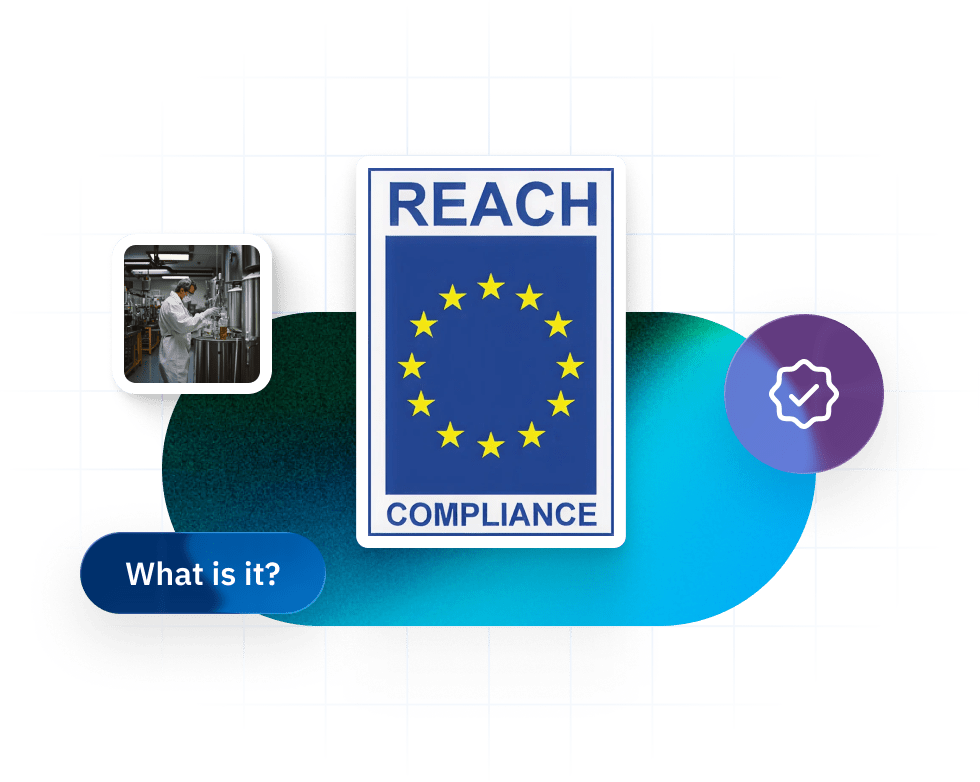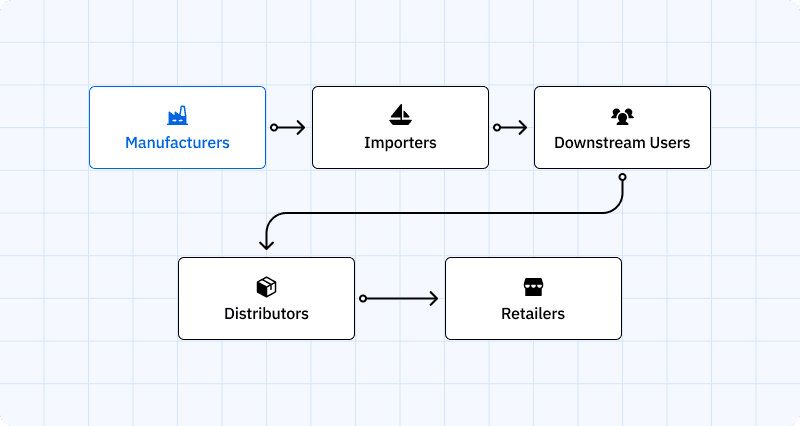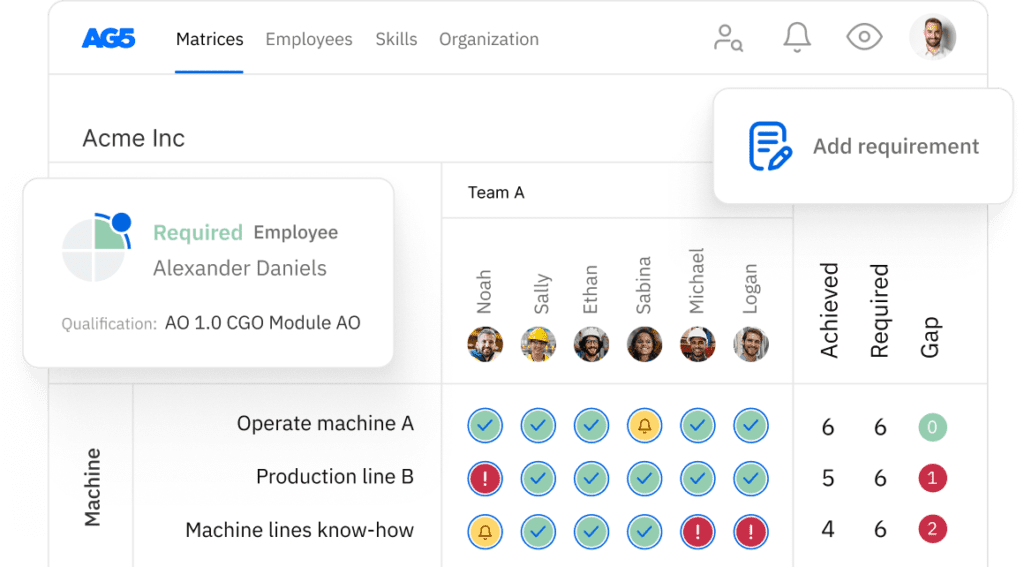What is REACH compliance?
REACH requires companies to identify and manage the risks linked to substances they manufacture and market in the EU, demonstrating how they can be safely used. In this article, we’ll explore the regulation set forth by REACH, the chemicals it encompasses, the organizations to which the regulations apply – and how AG5 can help you achieve and maintain REACH compliance.

What is REACH?Copied
REACH (Registration, Evaluation, Authorization, and Restriction of Chemicals) is a European Union regulation that protects human health and the environment from risks posed by chemicals. [1]
It is one of the most comprehensive and complex chemical regulations in the world, encompassing more than 20,000 chemicals and affecting nearly every industrial sector that manufactures, imports, or uses chemicals. The regulation places the responsibility on companies to ensure that chemicals produced, imported, sold, and used in the EU are safe.
What are the REACH compliance requirements?Copied
REACH compliance requires several key obligations from businesses that use or sell chemicals.
Registration
Companies must register substances manufactured or imported in quantities of tone or more per year with the European Chemicals Agency (ECHA). This registration includes detailed information about the substance’s properties, hazards, and safe use.
Evaluation
The ECHA and EU member states evaluate to clarify if a substance poses a risk to human health or the environment.
Authorization
Substances of Very High Concern (SVHCs) require authorization before use or sale [2]. To obtain authorization, companies must prove that the risks associated with the use of these substances controlled. They must also place some focus on eventually replacing SVHCs with “suitable alternatives”
Restriction
If manufacturing, using, or selling a particular substance poses a risk the ECHA deems unacceptable to health or the environment, it can be restricted or banned entirely.
Communication
Consumers and companies are allowed to inquire about the presence of potentially harmful chemicals in the products they purchase or use. They can make use of the LIFEaskreach program [3] to exercise this right. Once an inquiry is submitted, organizations have 45 days to respond.
 Copied
Copied
Why is REACH important?Copied
REACH is important for myriad reasons. Let’s take a look.
- Protection of human health. By identifying and controlling hazardous chemicals, REACH helps reduce exposure to toxic substances that can cause serious health problems, including cancer, birth defects, and hormonal disruption
- Environmental protection: REACH aims to prevent chemicals from contaminating air, water, and soil, thus protecting ecosystems and biodiversity
- Market access. Compliance with REACH is necessary for businesses to legally access the EU market, which represents one of the largest economies in the world
- Innovation. REACH encourages organizations to develop safer alternatives to hazardous chemicals, driving innovation in sustainable chemistry
- Consumer confidence. REACH creates transparency surrounding the chemical content in products. This can build consumer trust and confidence in the safety of products they purchase or use
How does REACH work?Copied
For companies, complying with REACH means adhering to legal obligations that ensure chemical safety throughout business operations and supply chains. We’ve outlined those obligations in the section above. However, in this section, we’ll take a closer look at the steps companies can take to ensure compliance.
- Register substances. If you manufacture or import a more than one ton of a chemical in the EU per year, you must submit a registration dossier to ECHA, share data with other companies using the same substance, and cover safe use, hazards, and risk management
- Maintain Safety Data Sheets (SDS). Safety data sheets (SDS) provide information regarding the use or sale of hazardous chemicals. Organizations should provide accurate, updated SDS to all downstream users – such as consumers or other businesses in the supply chain.
- Notify use of SVHCs. If a product contains more than 0.1% of an SVHC, you must notify ECHA – and inform recipients, so they can use the product safely
- Obtain authorization. If you use an SVHC on the REACH authorization list, you must apply for permission and demonstrate no safer alternatives exist
- Comply with restrictions. Do not use restricted substances in ways that are banned or limited under REACH – even if they’re registered
Examples of banned substances under REACH and whyCopied
Several substances are banned or severely restricted under REACH due to their hazardous properties. [4] We’ll cover a few of them here, but any organization interested in complying with REACH should review the full list on the ECHA’s website.
Phthalates (DEHP, BBP, DBP, DIBP)
- Use. Plasticizers in PVC and other plastics
- Reason for restriction. Reproductive toxicity and endocrine-disrupting properties
- Impact. These restrictions have driven significant reformulation of consumer products, especially children’s toys and childcare articles
Perfluorooctanoic acid (PFOA) and related substances
- Use. Water and oil repellents, non-stick coatings
- Reason for restriction. Persistent, bioaccumulative, and toxic; linked to cancer and immune system effects
- Impact. Has led to development of alternative fluorinated and non-fluorinated technologies
Chromium VI compounds
- Use. Metal plating, leather tanning, wood preservation
- Reason for restriction. Carcinogenic, mutagenic, and toxic for reproduction
- Impact. New approaches to chrome plating and leather manufacturing in Europe
Lead compounds
- Use. Pigments, stabilizers in PVC, batteries
- Reason for restriction. Neurotoxicity, particularly harmful to children’s brain development
- Impact. Has accelerated the shift to lead-free alternatives in electronics and other sectors
Bisphenol A
- Use. Production of polycarbonate plastics and epoxy resins
- Reason for restriction. Endocrine disruptor linked to reproductive, developmental, and systemic effects
- Impact. Has driven innovation in BPA-free materials for food contact applications
Decabromodiphenyl ether (DecaBDE)
- Use. Flame retardant in textiles, plastics, and electronics
- Reason for restriction. Persistent, bioaccumulative, and toxic; potential developmental neurotoxicant
- Impact. New approaches to flame retardant strategies across multiple industries
 Copied
Copied
Who does REACH apply to?Copied
REACH has a broad scope of application, and applies to almost all aspects of the supply chain.
- Manufacturers. Companies that produce chemicals within the EU, regardless of the volume produced
- Importers. Entities that bring chemicals or products containing chemicals into the EU from non-EU countries.
- Downstream users. Companies that use chemicals in their industrial or professional activities, including formulators of mixtures, industrial users, and producers of articles
- Distributors. Businesses that store and place chemicals on the market for third parties
- Retailers. Companies selling chemicals or articles containing chemicals to consumers
Consequences of not complying with REACHCopied
Non-compliance with REACH can result in severe penalties and business impacts.
Legal penalties and liabilities
Fines for non-compliance vary by EU member state but can range from thousands to millions of euros. In some countries, serious violations can even result in imprisonment. Additionally, injuries or environmental damage caused by non-compliant substances could result in civil or criminal liability.
Market access restrictions
Products that don’t comply with REACH requirements can be withdrawn from the market, resulting in lost sales and market share.
Reputational damage
Companies found to be non-compliant may suffer significant reputational harm, affecting customer trust and investor confidence.
Supply chain disruptions
Non-compliant substances or articles may be rejected by downstream users who require REACH compliance from their suppliers. Additionally, companies who do not comply with REACH regulations may be subject to increased regulatory scrutiny and monitoring, which can be costly and time-consuming.
How AG5 can help you stay compliant with REACHCopied
AG5’s skills management software provides essential tools to help organizations achieve and maintain REACH compliance.
With AG5, you can easily and quickly place a focus on:
- Qualification tracking. Ensure that employees handling chemicals have the necessary qualifications, certifications, and training to comply with REACH regulations
- Training management. Schedule, document, and verify REACH-related training for relevant employees, so you can be sure they understand their responsibilities regarding chemical handling and reporting
- Compliance documentation. Maintain centralized records of all REACH-related qualifications, training, and certifications for easy access during audits
- Skills gap analysis. Identify gaps in your team’s REACH compliance knowledge and address them through targeted training initiatives
- Real-time monitoring. Keep track of expiring certifications and required trainings so you can maintain REACH compliance
- Audit preparation. Generate comprehensive reports on staff qualifications and training related to REACH compliance to demonstrate due diligence during inspections
- Customizable compliance workflows. Set up workflows that align with your specific REACH compliance needs based on your industry and the chemicals you handle
Want to see how this would work in your organization? Schedule a free, live, 15-minute demo for a custom look.
Sources Copied
- Change view: Table
-
APA
| # | Source title | Description | Publication | Retrieved | Source URL |
|---|---|---|---|---|---|
| 1 | REACH Regulation | To protect human health and the environment against the harmful effects of chemical substances. | November 1, 2024 | May 22, 2025 | https://environment.ec.europa... |
| 2 | Authorisation process | - | June 4, 2017 | May 22, 2025 | https://echa.europa.eu/authori.. |
| 3 | LIFE AskREACH | LIFE AskREACH helps consumers and companies to apply the “Right to Know” about substances of very high concern in consumer goods | January 1, 2020 | May 22, 2025 | https://www.askreach.eu/.. |
| 4 | Substances restricted under REACH | - | January 1, 2020 | May 22, 2025 | https://echa.europa.eu/substan.. |

